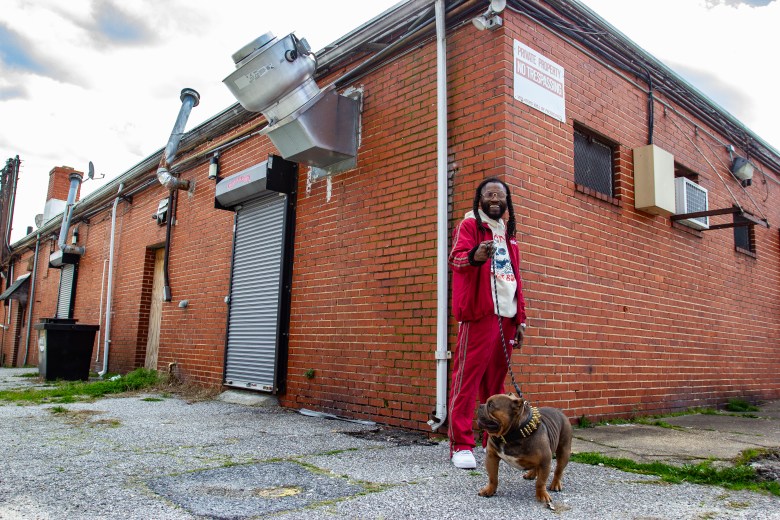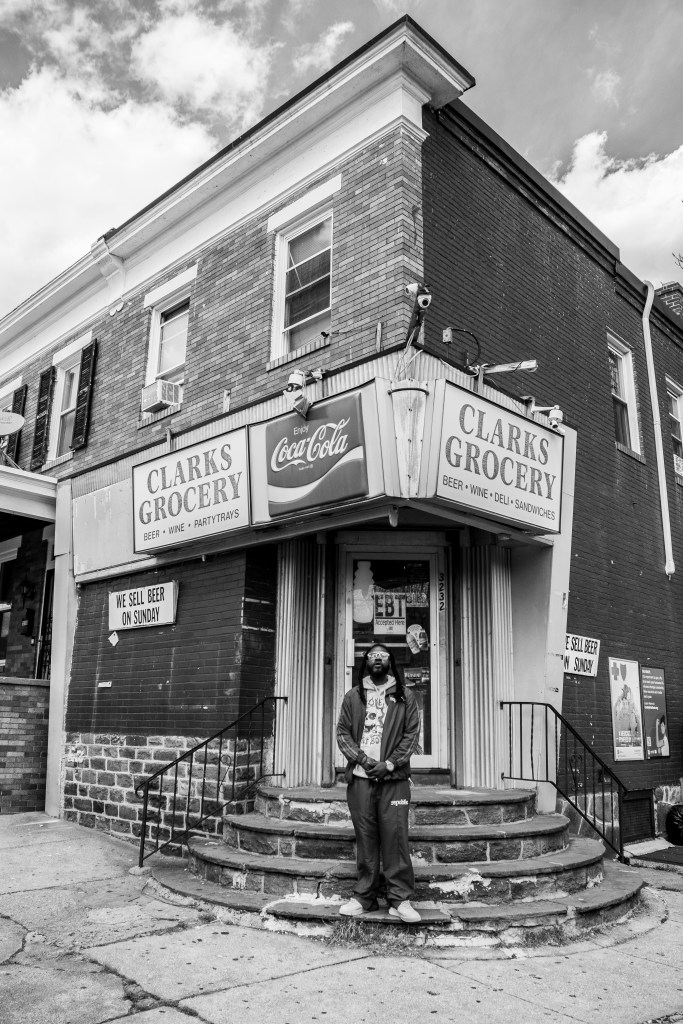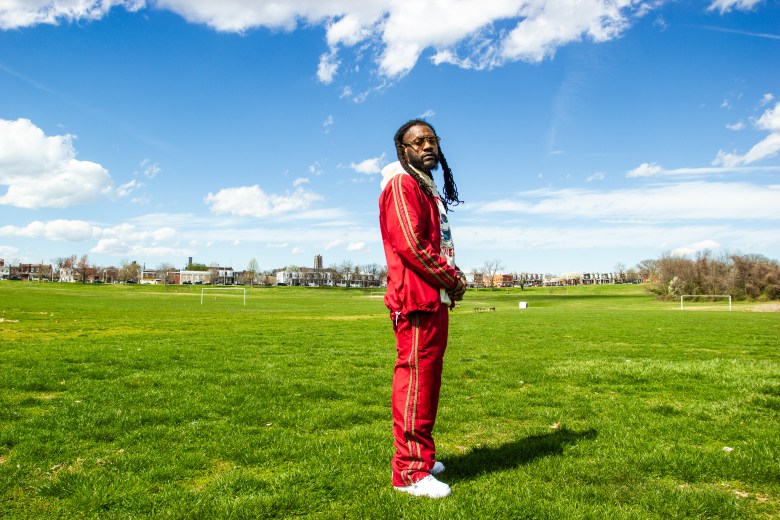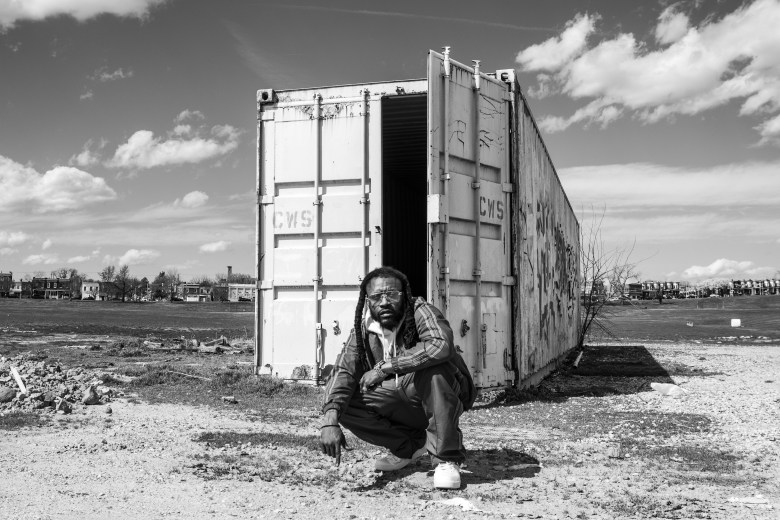Drive north on Sinclair Lane, just past Federal Street on your right-hand side, and you’ll see Claremont Freedom, an attractive, fairly modern community with plenty of colorful houses. It looks like someone took a neighborhood from Montana and sat it in northeast Baltimore City. You’d never think it was once the Freedom Way housing complex, home of one of Baltimore’s most unsung heroes — the rapper, producer, actor, and entrepreneur Tim Trees, aka Wayne Jones.

If you were to ask any Baltimore artist alive in the early 2000s (whether they specialize in hip-hop, club music, or anything else) what comes to mind when they hear Trees’ Rod Lee-produced “Bank Rolls,” the Paula Campbell anthem “How does it Feel,” or his classic “We Don’t Love ‘Em,” you’ll immediately learn the weight of Trees’ impact. In the early 2000s, Trees was one of the only artists from Baltimore that you were guaranteed to hear several times a day on local radio stations and in clubs throughout Baltimore and the DMV.
In the early 2000s, Trees was one of the only artists from Baltimore that you were guaranteed to hear several times a day on local radio stations and in clubs throughout Baltimore and the DMV.
“When I hear the original “We Don’t Love Em” by Tim Trees, my favorite childhood memories instantly resurface,” local rapper and recording artist Miss Kam told Baltimore Beat. “As a youngin, I memorized the whole song because if you didn’t know the lyrics, were you really from Baltimore?”
“Tim Trees’ music feels like Baltimore culture,” songwriter, producer, and director StarrZ says on a call from a recording studio in Los Angeles. “It’s a sound we originated when it comes to Baltimore rap. Unapologetic, beautiful sounds.”
But just a few years before his music became widely known, Trees was one of the Freedom Way residents pushed out of their homes due to redevelopment. Fifteen-year-old Trees, living with his grandmother, was forcibly uprooted from the neighborhood he’d grown to know and love.They would move to what felt like worlds away — the Bel Air Edison community.
“During that time, I was starting to rebel. I didn’t want to move. I just ended up going back around the way. It was only a 10-minute walk,” Trees tells me with a laugh. The Freedom Way’s surrounding neighborhoods still housed friends and family, so communing there during early redevelopment was easy.
His story is a typical Black Baltimore story. But only if you leave out his music’s legendary impact on the city. Trees, unlike many legendary street rappers, has survived the ugly parts of street life and continues to talk his shit with hunger. Paired with the amount of love and support he still receives, moving through the city as a fellow working man, his story is untold by the ‘once you get on, you gotta move away’ narrative. He’s still here, very much still working.
Growing up in East Baltimore, the rapper was surrounded by his family’s love for gospel music. His mother, grandmother, aunts, and even his great-grandmother sang for the St. Francis Xavier Church choir. The church choir produced an album. A young Trees saw members of his family and people he knew on an album cover for the first time. The environment planted seeds of exploring his own musical abilities.
“Every Sunday, if one of them had a solo, it was a thing, and you had to hear about it that week leading up to it and the week after,” he said.
The rhythm and soul, often found in that old-school gospel, mixed together with his reality, would naturally translate into his affinity for hip-hop. After all, the entire culture is built heavily on the braggadocio of an emcee and their authenticity when storytelling, but also, most importantly, the ability to ride a beat and deliver the soul of the track. It’s no surprise his early influence is N.W.A.
“I just liked the way they put the bars together,” he remembers.

Trees and his close friend and collaborator Dynamite Lay met with me on a fairly warm Saturday night in January at Bloom’s, a swanky Mt. Vernon bar inside the Ulysses hotel.
“I’m always trying to top that guy,” he says of his younger self, sipping a pineapple-based mocktail. He’s a Muslim now, and he does not drink. He’s also a brand new grandfather who recently starred in the movie “Check Please,” an Alvin Gray film slated for a May 1, 2024, release. The film also stars other homegrown celebrities like Paula Campbell, Walter Maxfield, Tesehki, Desi Alexander,and Erica Kane.
In 2023, Que Pequeño, producer, D.J., and co-founder of the Tew World Order collective, set out on a mission to curate 100 shows. The culmination of this project would be having Tim Trees headline the 100th show at The Crown. The Saturday night crowd would be made up mostly of people who were babies in 2001 when Trees first had the city in a chokehold.
“With the combination of it being my 100th show and 50th “808” show, I thought it would be dope to have him because he laid the groundwork for us,” Pequeño told me.
Trees hit the stage, accepting an explosion of applause, cheers, and enthusiasm. He would repay the crowd by performing a jubilant set of new, rare, and classic tunes with sincere gratitude to the younger heads who came to see him.
Consider rapper StarrZ’s 2017 video “Wayne Jones” and Tate Kobang’s 2015 “Bank Rolls Remix,” both created with help from legendary producer Rod Lee. You not only hear the influence and obvious tribute to Trees; you also see a pioneer who deserves to get more credit. Or does he? The better question is whether he wants it.
In conversation with Trees, you quickly find out that he’s an artist and that it was never about fame. The displeasure of meeting artists who had a similar run or legendary moment is that sometimes they still live in that place. That’s all they want to talk about. But you have to ask Trees about it. He wants to talk about now and tomorrow, if he talks to you at all.
“At first, I didn’t learn how to be a people person. I’d only deal with my circle because I was taught when you get too friendly, you know, that mean you kinda loose, and that’s when things happen. But as I got older, I realized everybody not tryna get you”
“At first, I didn’t learn how to be a people person. I’d only deal with my circle because I was taught when you get too friendly, you know, that mean you kinda loose, and that’s when things happen. But as I got older, I realized everybody not tryna get you.”
rapper, producer, actor, and entrepreneur, Tim Trees
Today, Baltimore rappers like StarrZ and Kobang live on a growing list of artists who have experienced success outside of Baltimore. So, remaking a Tim Trees song as part of their catalogs is a choice, and a respectable tribute, not easily approved by the originator.
“When people bring ideas to me, a lot of times I don’t like it. But when shorty [StarrZ] holla’ed at me, I was just like, ‘This sounds good. The idea sound good.’ And when I actually heard the song, …it sounded different.”
But Tate Kobang’s remake of “Bank Rolls” came to him differently,
“The hood told me about that. I didn’t hear the song at first, but people were talking about it. His cousin hit me up, and I was like, ‘What, he said something slick on there?’” He laughed.
“It was Ramadan 2015. So, during Ramadan, we’re not supposed to beef or get into any type of altercations or anything like that. So the way that my brain was when he was coming to me with the information… I was open to it.”
Kobang’s remake would place the younger rapper in the national spotlight, gaining commercial placements and taking his Baltimore sound worldwide. Earlier this month, Tate Kobang stepped onto the stage of a packed C.F.G. Arena for Nicki Minaj’s “Pink Friday 2 World Tour.” Kobang is signed to her record label as an artist and producer, but many of Tate’s out-of-state fans are unaware of the origin of his 2015 breakout hit, making it an exclusive Baltimore gem to those of us who know.

Trees’ style epitomizes Baltimore’s comfort with the unadulterated truth. Vulgar, yet comical and relatable, he’s always been able to weave in the “one up” on his opponent and tell the heartbreaking vulnerability of city life through his lens.
On his 2020 single “Whispers,” he raps, “Same ’ole Tim Trees, different flow/ Lyrical exercise recognize the difference though/ I aint ya average or typical/ I’m once every blue moon/ niggas dress like bitches but act like they true goons.”
“I was, like, 12 years old when I wrote my first verse. That’s when I was still around the way, but I couldn’t really cuss in front of my mother and my grandmother, so it was something I had to keep secret,” he said. “My homies didn’t even know till like 3 years later. Like, my area, you couldn’t display certain talents back then. You know how it is, when you like, in a project area, niggas will get out on you.” He says this speaking on how being a rapper is trendy now. In the ’90s, it was not as trendy to rap.
Baltimore, like many American cities in the ’90s, was caught in the violent grip of the war on drugs. We were worlds away from New York, where the genre originated, and which was home to more outlets for rappers. It was not a realistic thing to pursue here. The internet was still a new thing and not quite accessible to everyone. There was no Instagram or TikTok for artists to reach fans outside of the city. Radio stations like 92Q and the late V103 played no local rappers. The best you could find was on Morgan State University 88.9FM’s Friday night “Strictly Hip Hop” from midnight to 5 a.m. Even then, it would only be a part of the “Test Bin” segment, where local artists submit their songs, and listeners call in to confirm it as a hit or trash it live on the air in real-time. I asked Trees where he was the first time he heard himself on mainstream radio.
“It was 2001. On a Saturday. I was at my man Dresta’s house. Anticipating K Swift to play “Bank Rolls” as part of a segment on 92Q.” He recalls.
“Dresta was ⅓ of Bdamore Records. That’s the label that I was with when I created Dalton Volume 1 or whatever. It was about a good 10 of us in there. We was sittin’ around waitin’ for it and once that shit played, it was exciting but I knew I had to get on top of my game, you feel me? I knew it was on because of how everybody was actin’.”
It’s a moment every artist dreams of, but so few get to experience. Hearing your song being played at a prime time to the entire city alongside the likes of Jay Z, Eve, D.M.X., and Missy Elliot.
He recalls mainly listening to “The Dynasty,” Jay-Z’s fifth studio album that served as a Roc A Fella records compilation, introducing the world to future legends like Beanie Siegel, Freeway, and a young Kanye West on production. Like most of Baltimore, though, he was also listening to a then-still underground Three6Mafia; notably, Project Pat’s “Mista Don’t Play…”
Yet, and still, “Bank Rolls”’ sounded nothing like any of it. It was undeniably Baltimore. The heavy bass drum, a slowed-down Baltimore club tempo, crisp claps, a jazz sample also used by A Tribe Called Quest trickling throughout, and the commanding voice of an East Side boy at the helm. The song rippled through the region.
People of all ages embraced the then-22-year-old’s proclamation “Bank Rolls, you think you gettin’ half of my dough you ain’t tho/ I got a Benz six oh oh you can’t roll/ Can I pay ya bills? hell no/ more paper, more cheese, more dough.”
People of all ages embraced the then-22-year-old’s ‘ proclamation, “Bank Rolls, you think you gettin’ half of my dough you ain’t tho/ I got a Benz six oh oh you can’t roll/ Can I pay ya bills? hell no/ more paper, more cheese, more dough.”
Twenty-three years later, it’s still a party and festival favorite during sets by both veteran and up-and-coming DJs. But, in true artist form, Trees has long left the period he calls short-lived. He’s never stopped making music, works with longtime friends and local rappers like Dynamite Lay, and genuinely wants to be there for any younger artists he can.

“Definitely home first, and whoever’s up and coming that needs a hand that I can lend,” he says.
The list of dope rappers from Baltimore who are slain by gun violence grows bigger and bigger every year, and it becomes easy to follow a narrative of fear that the city isn’t a safe place for rappers to grow old. Tim Trees is an exception and a representation of our true nature as people in this city. To show love to those who show love. Do your thing and stay out of the way.
I asked him, “What’s next?” and he responded with what I imagine to be the same enthusiasm about his craft that he had at 22 years old.
“More music, more merchandise, more movies.”
